

|
Essays on the Marshallese Past
All Animals are marked and so shall you -
|
In traditional Oceanic cultures tattooing is closely connected to the social and spiritual custom of a population. The motif complex utilised by prehistoric and historic populations in the
Body ornamentation comes in three forms: body painting, The Tattoo Motifs
Even more to the point, tattooing in general is called eo, which according to the German ethnographer
Spiritually and conceptually

If the term
At the time the Marshallese tattoos were recorded by traders and ethnographers there was little variation within the individual atolls of the Marshall Islands.
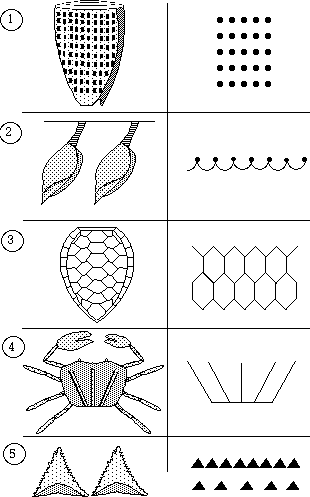
Marshallese tattooing motifs (right) and their natural examples (left). 1-Conus ebraeus and the addilajju motif; 2-Lepas anserifera and the elo¾wˆ motif; 3-Back of a turtleˆs carapace and the b–d motif; 4-Back of crabˆs carapace and the addijokur motif; Sharkˆs teeth and the pako motif.
However, according to oral tradition reported by
The Marshallese tattoo motifs are in general character very abstract pictographs, their meaning, as outlined above, finds its roots in the environment: markings of fish, tooth marks of fish bites, motifs resembling shells or their ornaments and so on. Figure 2 shows a set of Marshallese tattoo motifs, namely the The Men's Tattoos
A men's tattoo is laid out in a series of ornament zones which bear descriptive names, such as "mast, ocean swell, boat, clouds" and the like, which find their origin in the seafaring nature of Marshallese men.
Let us first have a look at the chest tattoos, then those on the back and finally at the other smaller tattoo areas, such as arms, legs, buttocks, face and so on.
Chest Tattoos
A complete men's chest tattoo consists of three main tattoo components, which can be added to. These main ones are the upper and the lower chest triangle as well as a central vertical ornament field.
The
The
Both chest triangles are split into two halves by the
Added to these three main components could be other ornament fields, such as a shoulder tattoo (see below), a tattoo on the side of the chest or a stomach band.
A
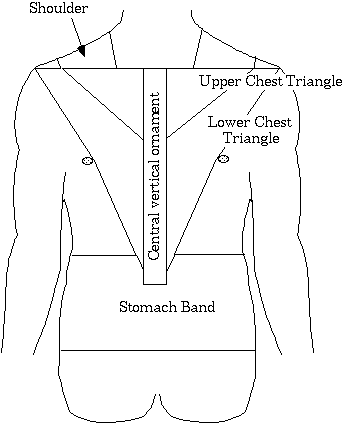
Men's Chest tattoo. Layout of the tattoo.
The area above the upper chest triangle canˆoptionally be filled with a shoulder tattoo, which is laid out in horizontal ornament bands. On the back, the shoulder tattoo also ends in a horizontal line connecting the shoulders. In addition, the upper part of the shoulder can be decorated Description of selected chest and shoulder tattoos
In the following a selection of complete chest and shoulder tattoos will be described, which have been recorded in the 1910s.
The chest tattoo of a young chief from
The lower chest triangle has slightly indented sides, with the nipples as the turning points. The field is covered with oblique
The central mast ornament field is well distinguishable from the upper chest triangle for the want of oblique strokes. At the junction of the upper chest triangle and the lower chest triangle the mast shows two pairs of three-pronged
The shoulder sections, save for the throat area, are tattooed with rows of
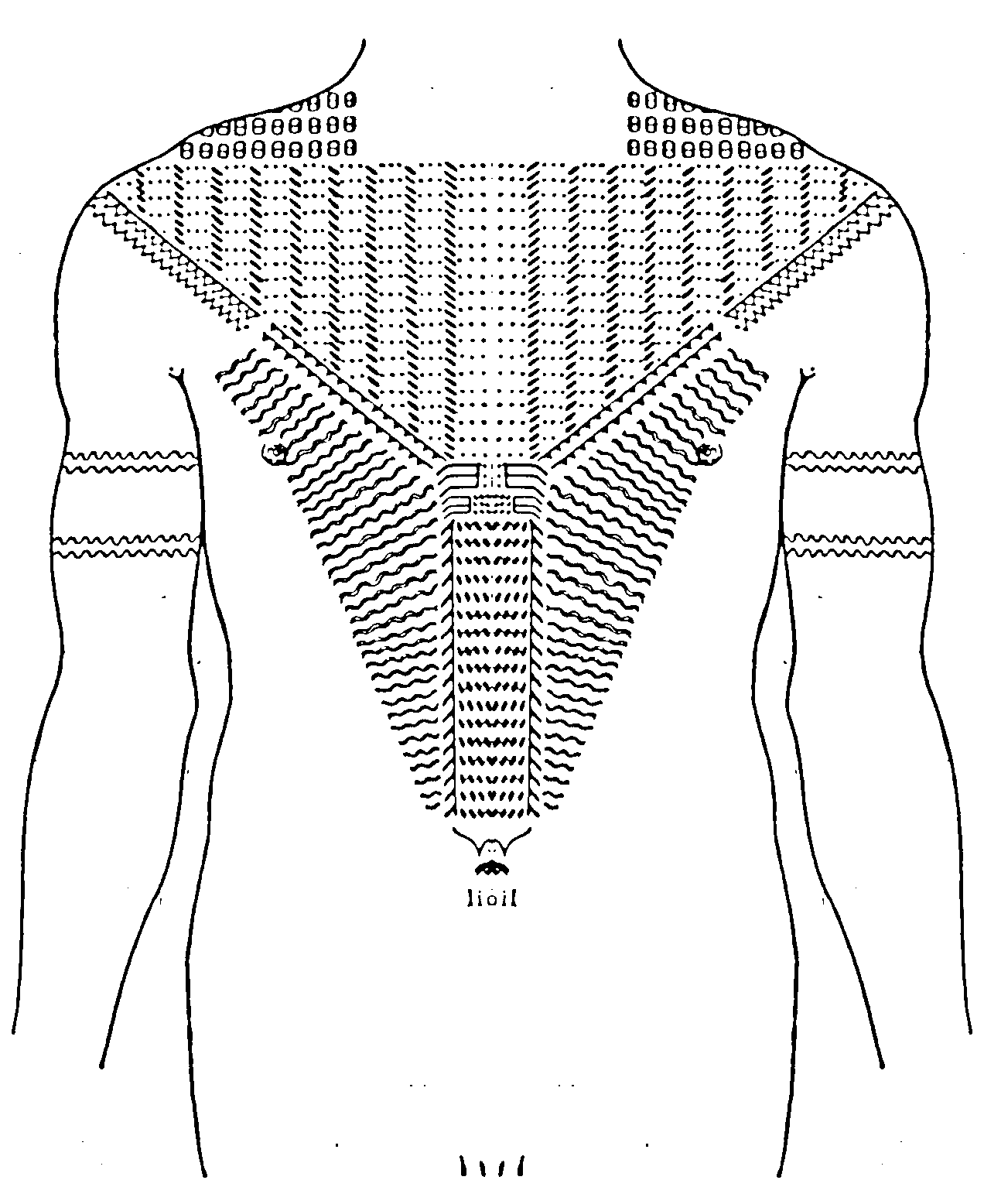
Men's Chest tattoos. Chest tattoo of a young chief from
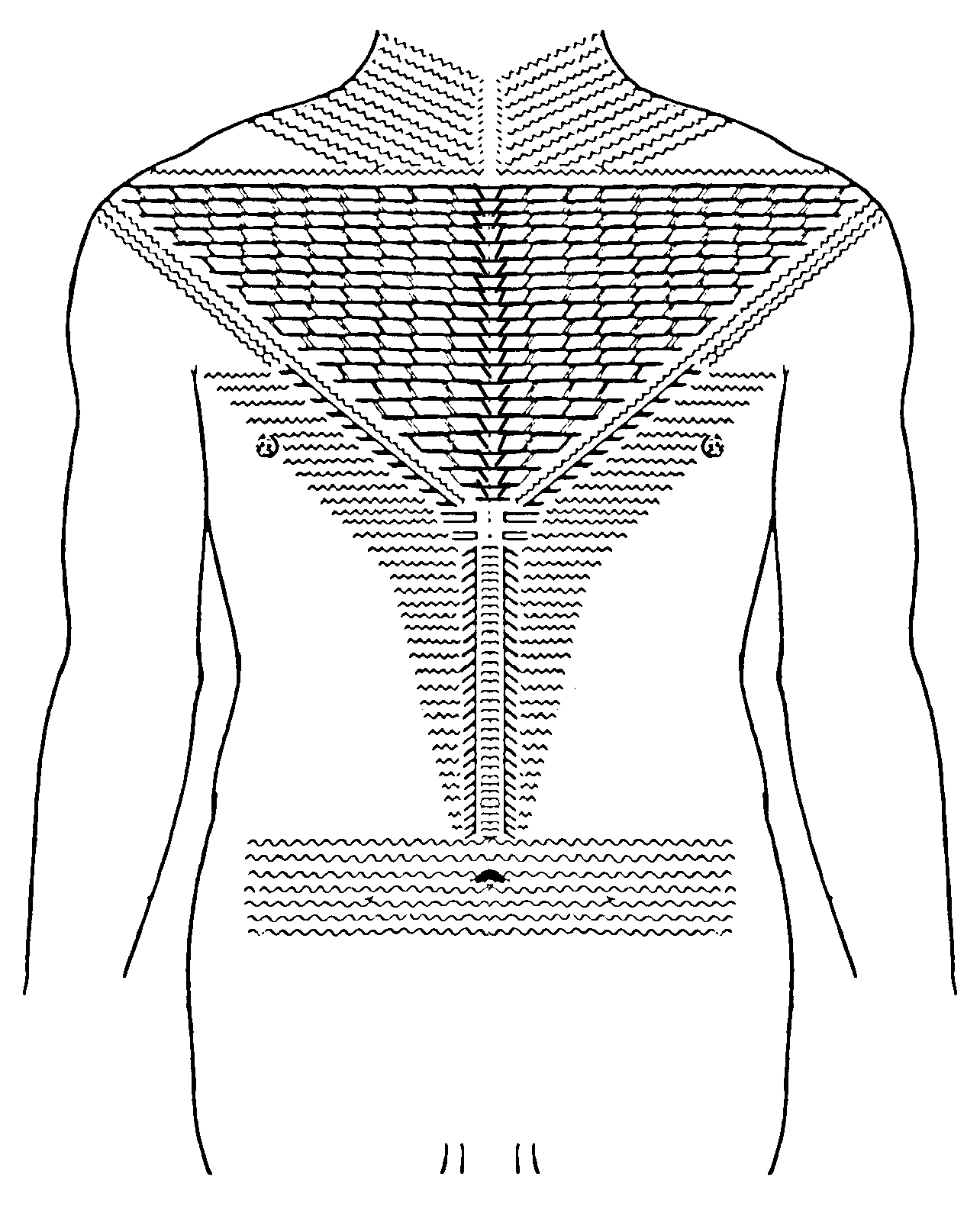
Men's Chest tattoos. Chest tattoo of chief from
Apart from the shoulder zone, the tattoos on the men's back consist of three ornament fields, the back triangle and upper back band and the lower back field.
The
The
The
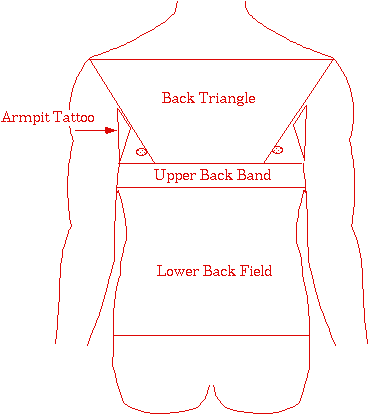
Men's Back tattoos.Layout of the tattoo.
In the following a selection of complete back and shoulder tattoos will be described, which have been recorded in the 1910s. The back tattoo of a young chief of
The lower back field consists of the complex
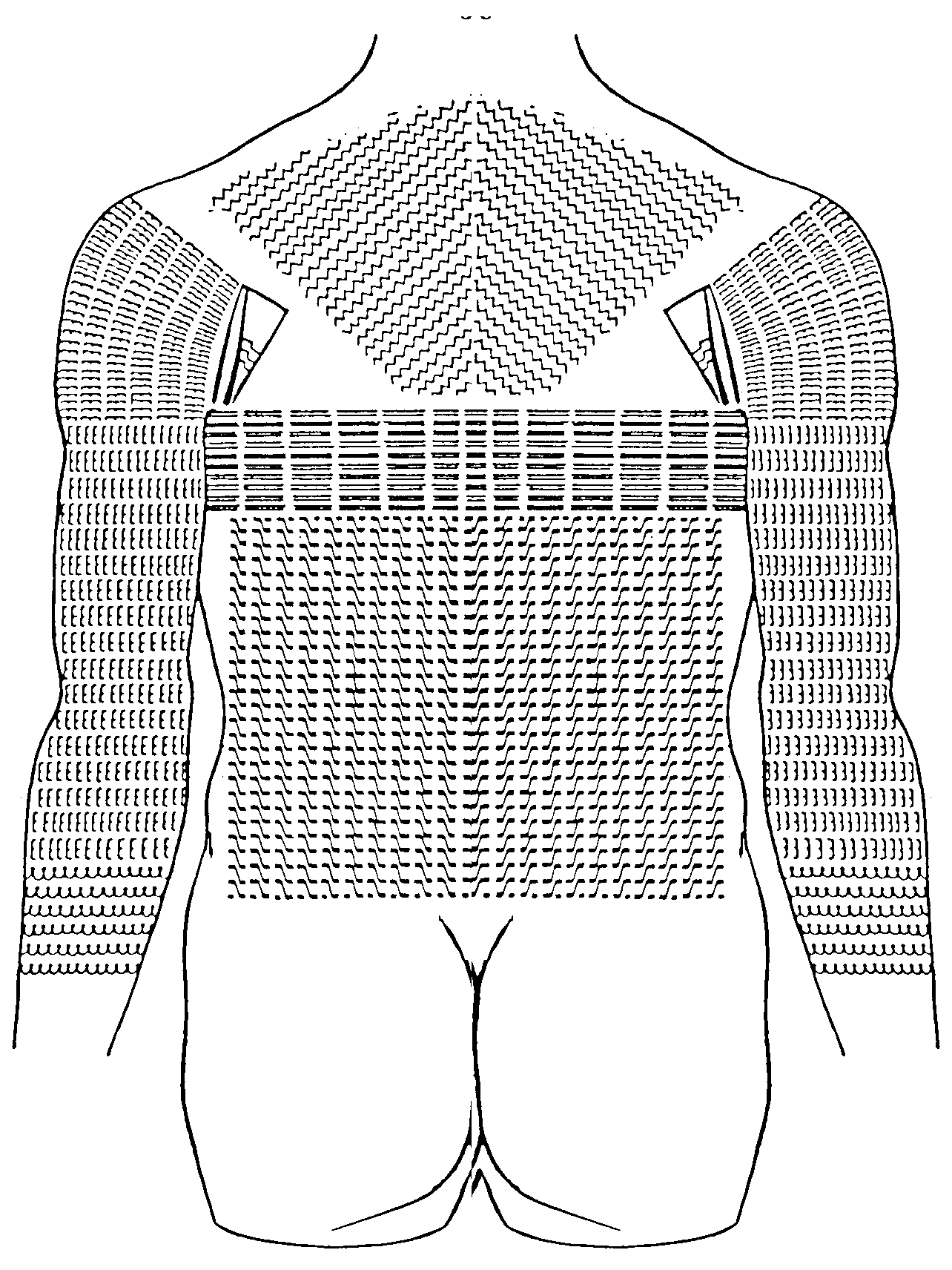
Men's Back tattoos.Back tattoo of a young chief from Jaluit Atoll
The upper arm areas are covered with horizontally arranged
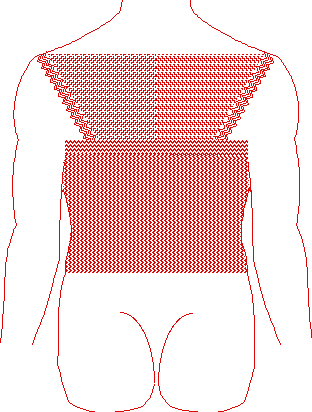
Men's Back tattoos.Back tattoo of a chief from
The lower arm area from the middle of the lower arm to the wrist is covered with Neck and Head Tattoos
Neck and head tattoos were restricted to males of chiefly rank. The neck tattoo
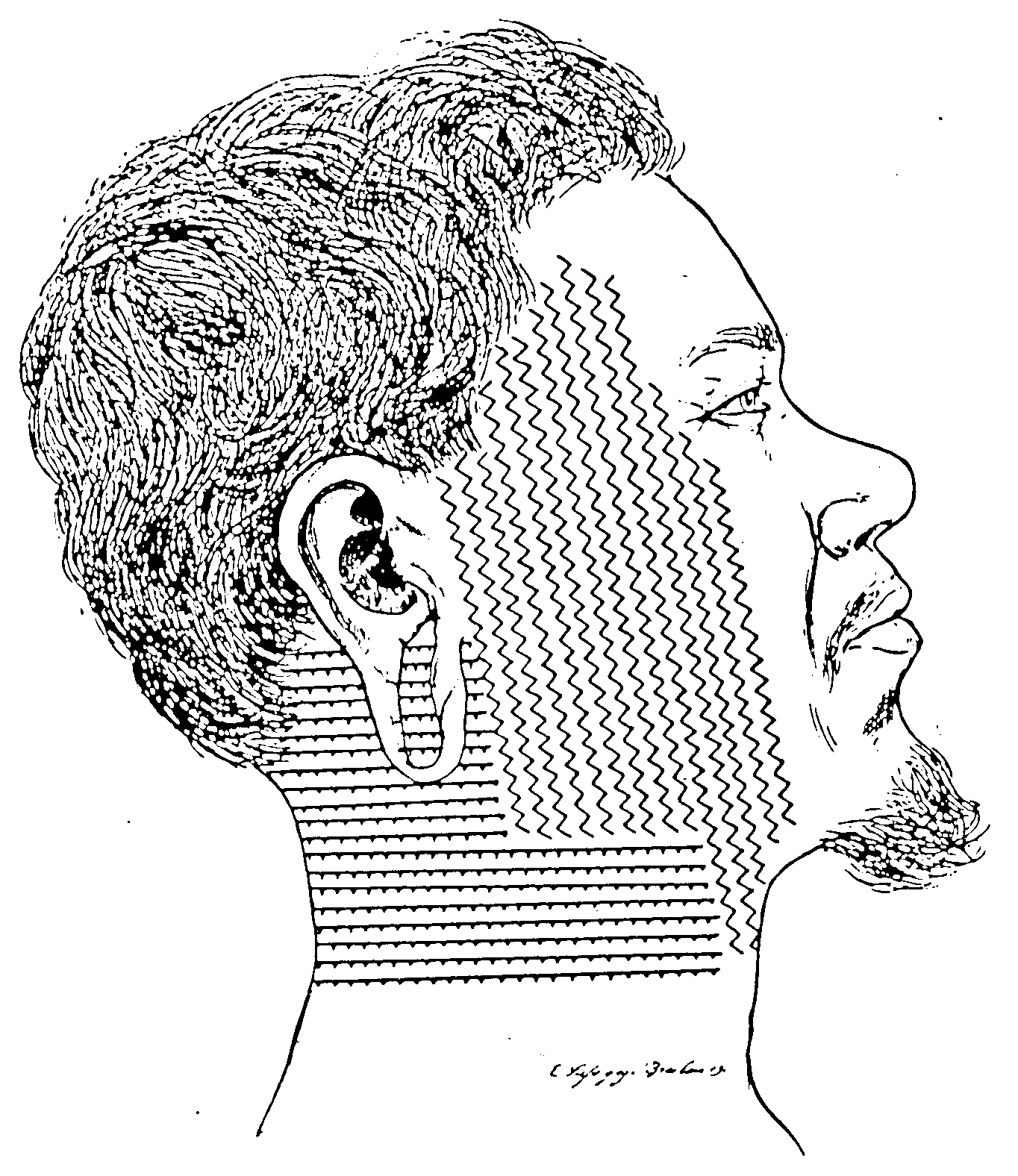
Head tattoo of
The
Arm Tattoos
The tattooing of the arms is very variable. It can consist of a few lines and in its full extent can reach from the armpits to the wrists. A full tattoo is traditionally divided into three main areas, the area of the upper arm, the area of the lower arm and the central part in between. Unlike in other areas the inside of the arms was commonly not tattooed in the Marshallese tattoos.
The area of the upper arm covering the deltoid muscle, is bordered by a line drawn between the armpit and the shoulder (onset of the caput humeris), while the lower border is less well defined, but often matches the upper margin of the upper back band. Very common is the tattooing of only a couple of bands around the upper arm. These bands, mainly using the zigzag line, go all around the arm in the form of a bracelet ( lukwo or roja¾pe ). A census of 238 men conducted in 1930 showed 56 to be tattooed with indigenous motifs. Of these the overwhelming majority (48) had only horizontal bands around their arms, as well as their legs.
The area of the lower arm extends about halfway between the elbow and the wrist to the wrists itself. Tattoo motifs are arranged vertically and are aligned in small horizontal groups, giving the arm a ringed appearance.
Leg Tattoos
Leg tattoos (w‘nne) are commonly restricted to the front and the middle of the outside of the upper thigh. Most leg tattoos are restricted to a few double lines or bands of the wavy-line or zigzag motif on their thighs and their calfs.
Other Tattoos
In addition to the main tattoos mentioned, men were sometimes tattooed next to the armpits, the buttocks, and the penis.
The buttock tattoo consists of a rectangular band which covers the lower os sacrum area and the occasionally the side of the buttocks.
The tattoo next to the armpits was executed on the person's back. It was a small triangle with a base pointing upwards and the tip pointing towards the side. This tattoo, which was very rare even at the end of last century, was primarily a chiefly tattoo, but may have been permitted for other men as well.
The data available on womenˆs tattoos are, overall, less frequent than data on menˆs tattoos. This is mainly due to the fact that the
Men in the entire group are tattooed on the back and breast, varying according to rank Tattooing is not practiced in the case of women.Ó
In fact, those Marshallese who maintained the tattooing after the intervention of outside forces were women, rather than the men. One exception in recording was that done by Elisabeth KrÇmer, who accompanied her husband Augustin to the Marshalls, and who could break through the gender barrier. According to all descriptions, womenˆs tattoos are substantially more uniform than menˆs. Womenˆs tattoos are also laid out in a fixed system of ornament zones, and the tattoos are restricted to the shoulders, arms, legs, and fingers.Ó
According to Father Erdland, the Marshallese placed great importance on the female shoulder tattoo, because as it is explained in sorcery rhymes and chants, the popularity of a woman is placed in her shoulders.Ó The shoulder tattoo is very complex and consists of a number of motifs. The female shoulder tattoo is also the only tattoo where pigment is used in a more surface-covering manner. Tattooing motifs seen in this ornament field include almost exclusively the bwilak motif of which several variations and combinations have been used.
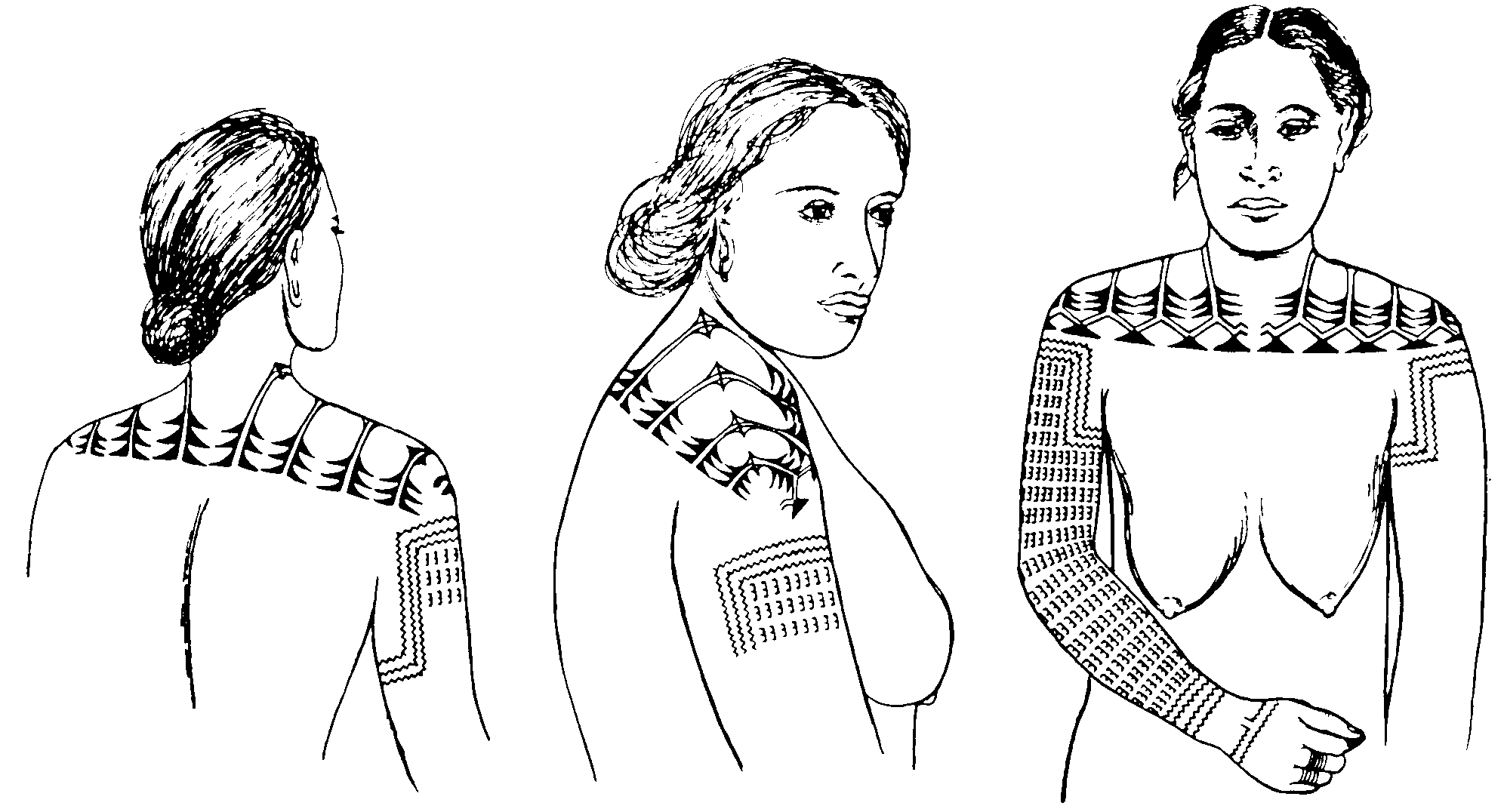
Tattooed Marshallese women (after KrÇmer)
We can distinguish two major types of womenˆs shoulder tattoos: Type I consists of the


Female shoulder tattoo Type Ia (top) and Type II (bottom) (the arrows indicate the shoulder line)
Type II a & IIb tattoos are similar to types Ia & Ib with the exception that the
The arm tattoo consists of two main parts, the decoration of the deltoid muscle and the decoration of the remaining arm to the wrist. The wrist area itself has another small ornament band. The deltoid muscle is commonly tattooed with a multiple zigzag band, which runs across the arm, then downwards at the side, across the back of the arm and up again on the inside. There can be three or four parallel bands of zigzags. Hasebe, relying on information by the tattooed person herself, identifies the deltoid muscle ornamentation as
On the whole, documented womenˆs leg tattoos were fairly rare. If recorded they consisted of a tattoo of the thighs and a separate and unconnected tattoo of the calf. The tattoos of the thighs were apparently confined to thin bands or single lines and were restricted to the front of the leg. The calf was decorated with horizontal lines only. Tattooing motifs seen in this ornament field include the zigzag tattoo.
The tattoo on the back of a hand

Marshallese Finger Tattoos
The finger tattoo
In addition, women could have a ËsecretÓ tattoo
For the creation of a pigment tattoo two main tools and a number of accessories were needed. The tools were the tattooing adze and the mallet which were used to deliver the pigment under the skin and to create the tattoo. A tail¡feather from a seabird was needed to draw the outline of the intricate tattoo, prior to the tattooing process. In addition, there were a receptacle for the pigment and a small mat, specially woven for the occasion to cover the head. In detail, the tattooing utensils needed were:

Schematic representation of tattooing utensils. AˆThe tattooing chisel, ngi; BˆThe mallet, jub; CˆDetail of a chisel; DˆThe pigment container air in eo; E-A small tattoo mat, bunninemij.
The tattooing chisel was made of bone, commonly a wing bone of an albatross or frigate bird, or ¡ in the late 1870s ¡ the femur of a domestic chicken. Sometimes bundled fish spines were also utilized. The larger the diameter of the bone, the straighter the chisel could be. Oral traditions show that the Marshallese went to the northern atolls, where nesting seabirds were abundant, to collect birds.
In the Marshall Islands the use of human bones for tool manufacture is known ethnographically, though not for tattooing needles. Tattooing chisels made from human bones, as part of ancestor worship and to foster clan cohesiveness are known from a large number of Pacific Island communities, where ethnographic descriptions could be made before the Pacific culture had changed under the influence of Europeans.
In order to manufacture the fine teeth of the chisel, a special file was used, made from a spine of a sea urchin, which had been ground flat into the form of a screw-driver head.
The tattooing would begin with the person lying on his/her back, having the upper part of the chest tattooed first, and ending on the nipples, an area where tattooing is very painful. A folktale indicates a different sequence, there first the shoulder and the back were tattooed while the person to be tattooed lay on a mat.
The tattooing would begin after the tattoo artist had drawn the days worth work of tattooing on the body, and the face of the person about to be tattooed had been covered with a small mat, especially woven for the occasion. The tattooist would then dip the tattooing adze into the pigment container (kadulo¾), place it on the skin and strike it with the mallet (kade).
A complete tattoo, both chest and back, would normally take up to a month among commoners, and even longer for chiefs as they had their legs and face tattooed as well.
While these time lines refer to complete body tattoos, it needs to be pointed out that tattoos commonly went in stages. Children and younger adults had a few lines or bands tattooed on their arms or their legs. With the onset of man- or womanhood, the children becoming full members of the adult society, they could attain a complete tattoo. Even later, if the individuals were of chiefly birth and rose to chiefly powers, the chiefly insignia, the chiefly markers, such as face tattoo for the men, or finger tattoo for the women, were added.
Because all traditional customs are being given up, tattooing had also become also a dying art in the mid of last century. Tattooing was also connected to ËstrengthÓ i.e. personal valor during the operation. Since the social values changed in the 1870s and tattooing has lost its significance ¡ Ëmuch to the regret of the chiefs and soothsayers, who formerly received much return for it.Ó
Exemplary of missionary attitudes may be the following. Describing a missionary visit to Hivaoa, Marquesas Islands, Warren (Boston Mission) mentions the tattooing of the Marquesas people and comments that
"their naked bodies were so disfigured by tattooing that their appearance was exceedingly revolting"
European aesthetic concepts also strongly prevail in the following passage:
"Tattooing is considered a mark of great beauty.... But we should consider the beauty of a man very questionable, to say the least, who had a large lizard pictured on each cheek, with its tail and legs spread in each direction, and looking as though it was ready to jump right into the manˆs eyes"
At another location the Marquesas people are said to "Ëtattoo their body horribly, from head to footÓ".
Tattooing was a custom which the missionaries had to put an end this for a number of reasons, each equally compelling to the missionaries:
On the balance, therefore, the missionary abhorrence towards tattooing was partially based on European narrow¡mindedness and European ideals of beauty and aesthetics, and ¡ for a fundamentalist ¡ was morally justifiable by the bible.
With the increased Christianization of the Marshall Islands and the wide¡ranging changes in traditions during the late 19th century tattooing had become outlawed and ceased to be conducted. The speed with which the missionaries could effect this change is astonishing.
In 1879 and 1880, when the German naturalist and ethnographer Otto Finsch lived for almost a year on Jaluit, Arno and Mile, tattooing was still practised, although already becoming rarer.
Men with complete tattoos were already a rarity, even among chiefs. Finsch estimated that about half of the adult population of the atolls seen by him was not tattooed, as well as almost all children.
In the 1930s the Japanese ethnographer Hasebe Kotondo undertook a survey of the Marshallese tattooing tradition and found that traditional tattooing was very much a dead art. He conducted a limited census of 348 men and women on Jaluit, and found that 16% had traditional patterns, 19.5% had European letters or motifs, while 64% had no tattoos at all.
Writing of his ethnographic observations on Majuro in 1946, Alexander Spoehr mentions that "neither tattooing nor enlarged ear holes in the ear lobes are common practices today, though probably most of the older people are tattooed on the arms and have enlarged piercing of the ear lobes".
Today, traditional tattooing is no longer practised and to the knowledge of the author or the Alele Museum there are no people alive who have complete traditional tattoos.

A small mat, possible a tattoo mat (bunninemij) collected on Jaluit in the 1880's (Knappe Collection; Photographs Courtesy Museum f‘r Th‘ringer Volkskunde, Erfurt)
| select from the following... | ||||||
| |
||||||
|
Digital Micronesia-An
Electronic
Library & Archive
is provided free of charge
as an advertising-free
information service
for the world community. It is being maintained by Dirk
HR Spennemann, Associate
Professor in Cultural
Heritage Management, Institute of Land, Water and Society and School
of Environmental & Information Sciences, Charles
Sturt University,
Albury, Australia. The server
space and technical support are provided by Charles
Sturt University as part of its commitment
to regional engagement. Environmental
SciencesInformation
Sciences
|
||||||